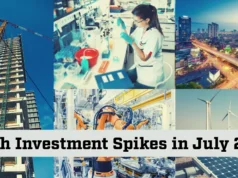 The revival in order inflow across all segments, decline in leverage ratio and interest rates, and improvement in working capital cycle is likely to hold the key to future growth of the Indian construction sector, says Teena Virmani, Vice President – Private Client Group Research, Kotak Securities.
The revival in order inflow across all segments, decline in leverage ratio and interest rates, and improvement in working capital cycle is likely to hold the key to future growth of the Indian construction sector, says Teena Virmani, Vice President – Private Client Group Research, Kotak Securities.
The performance of the construction sector during the past few quarters has been impacted by a range of issues such as policy delays, lack of order inflows as well as slowdown in execution. Delays in payments from clients and stretched working capital coupled with high interest rates have resulted in keeping leverage at higher levels for the sector. Slowdown in GDP growth also resulted in lower than expected traffic growth for road BOT projects.
Government has been initiating steps to revive the sector like delinking of forest and environmental clearance, working out on modalities of providing complete exit to road developers, and putting large sized infrastructure projects on fast track. However, on the ground improvement is currently not visible.
We analyse the order inflows, execution, profitability and borrowings of various companies, and recommend a selective stance on the construction sector. Going ahead, revival in inflow across all segments, decline in leverage ratio and interest rates coupled with improvement in working capital cycle is likely to hold the key to future growth.
Order inflow
Order inflow for most of the companies has witnessed deterioration. Compared to FY12, road sector awards from NHAI witnessed a sharp decline due to issues related to land acquisition as well as environmental clearance coupled with lack of interest from players for unviable BOT projects.
Thermal and hydropower, industrial, railways and bridges continued to witness lacklustre activity.
But traction is seen in buildings, water supply as well as urban infrastructure segments for players like NCC Ltd, Simplex Infrastructures Ltd, Unity Infraprojects Ltd and Pratibha Industries Ltd. However, ILFS Transportation Networks Ltd benefited from excellent order inflow in the past couple of quarters. We believe that going forward, though order inflow has declined, execution of current order book holds the key to future growth. Most of the players have slowed down execution to prevent working capital from stretching further due to delays in payments from clients.
 Operating margins
Operating margins
Margins have stood a mixed bag for the companies during Q1 FY14 but, going forward, increased competition, fixed overheads as well as change in project mix are likely to restrict significant improvement in margins. We thus expect full year margins for FY14 to be slightly lower than that of FY13.
High working capital cycle
Working capital cycle has continued to remain on the higher side for most of the players led by decline in customer advances due to lack of order inflows, higher receivables due to delays in payments from clients as well as high loans and advances to subsidiaries. This has resulted in increase in borrowings for the June quarter as compared to March quarter. Various companies such as JP Associates, NCC Ltd, IVRCL etc. have been in the process of raising funds at the SPV level to reduce borrowings. JP Associates has managed to sell its Gujarat cement unit to UltraTech Cements Ltd and expects to reduce standalone borrowings by 15 per cent. NCC Ltd has also sold stake in some of its projects and expects to raise further funds. We expect borrowings and working capital cycle to come down during FY14 for these companies.
Near term outlook
In the near term, interest rate movements continue to play a major role for the construction sector. The sector had expectations of interest rate cycle reversal during this fiscal. However, due to rupee depreciation and liquidity crunch, interest rates on short-term working capital borrowings have moved up and continue to stay at higher levels for long-term debt. Thus, continued high interest rates may keep the profitability subdued for companies in the infrastructure sector for a few more quarters.
Along with this, the impact of monsoons is also likely to be felt on the execution of companies. Poor execution coupled with high interest rates may keep profitability adversely impacted during Q2 FY14 also. Further, progress on stake sale in various projects by players like JP Associates, NCC Ltd and IVRCL would be keenly watched as it will result in reducing high cost borrowings.
Medium- to long-term outlook
Over medium to long term, we would prefer players having good balance sheet strength, ability to tap upcoming opportunities in the order inflows as well as attractive valuations. Triggers that can result in re-rating of the sector would include:
- Improvement in order inflows across segments
- Reversal of interest rate cycle
- Faster environmental clearance and land acquisition for projects, especially road and power projects
- Reduction in borrowings by stake sale or improvement in working capital cycle
- Financial closure of pending projects
Some improvement in these parameters is being witnessed such as government putting infrastructure projects on priority and stake sale witnessed in some companies but further improvement on remaining parameters is still awaited.











